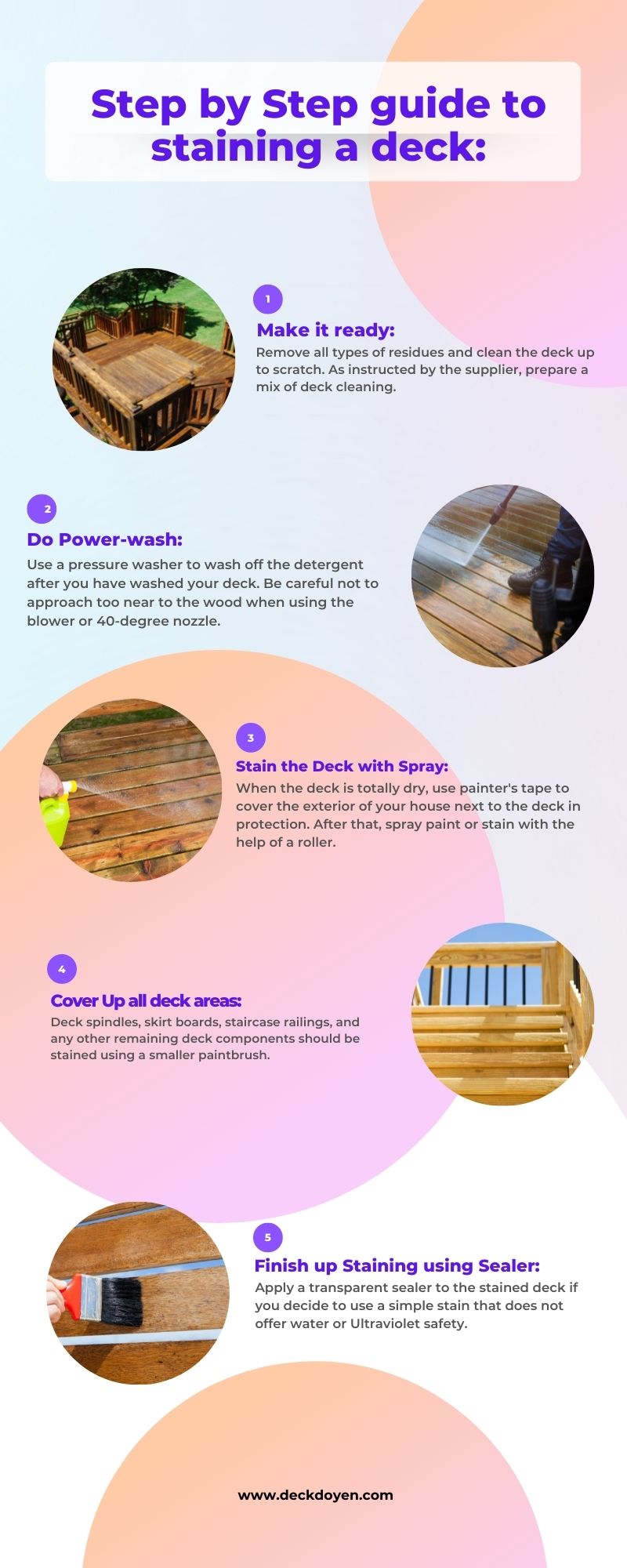Whether it’s heavy rain or masses of snow, water damages a wood deck’s surface; if your deck stain resists rainwater, it still effectively shields the wood. If not, it’s time to stain once more. So, it’s crucial to understand when to stain a new deck.
It is simple to choose the ideal time to stain your deck. All you have to do is consider the deck’s age, the climate, and the type of deck stain you intend to use. If you leave it untreated for too long, its materials will start to deteriorate, creating an unstable surface with exposed bolts and wood that is prone to splinters.
Understanding when and how to stain a deck effectively will increase its lifespan and make outdoor gathering a tension-free and peaceful way to enjoy the summertime. Here I will explain some pro tips and techniques for completing the task effectively.
When To Stain A New Deck?
Your deck must be well-maintained and capable of enduring the damaging factors that nature can throw out. Your deck may appear old and weathered due to the sun, rainfall, frost, or even the breeze. Your deck can benefit from Staining, restoring the structure’s appearance, and making the deck last longer.
Staining your deck is the finest option when the time and weather cooperate. How lengthy it will take you will rely on how big your deck is. In the end, you should reserve a minimum of two days. It can take you an additional day or two if you want to clean your deck or repair any wood thoroughly.

Early spring staining might cause flaking or splitting because the wood’s pores are still moist and cannot readily absorb the treatment. The stain may dissipate too rapidly in the summer because of the hot temperatures, making it impossible for the coating to infiltrate into the wood properly. When the atmosphere and wood surfaces are between 50° and 90°F, apply stain. Prevent doing so in direct bright sunlight. Do not apply stain if rain is expected within the next 24 to 48 hours.
The best time of year to stain your deck is when the weather is moderate and pleasant. When staining your deck, intense heat or sunlight might harm your efforts. The deck may dry up too rapidly under strong sunlight, leaving wet stains. Try to stain your deck if there aren’t any rainy days in the forecast and the temperature won’t exceed 80- or 85 degrees Fahrenheit. By doing this, you will permit the weather to work for you instead of working against you.
Also Read: Deck Vs. Porch: Real Differences Explained!
How Much Should You Leave A New Deck Dry Before Staining It?
The kind of wood your deck is composed of will determine the optimal time to stain it.
- You must wait a minimum of three months prior to actually staining your deck if it is composed of brand-new, polished wood.
- As long as the wood is completely dry and clean, rough-sawn wood can be dyed immediately away.
- It will range from one to two months before you may dye kiln-dried wood and KDAT wood.
The Ideal Time To Stain An Old Deck:
How frequently should I stain my deck? It is a common question from householders. A deck must be stained every approximately two to three years to keep it looking fantastic and extend the life of the wood.

If not all the wood is stained at the exact moment, it will be challenging to get a uniform color and appearance on the entire deck. The whole deck should be retracted if some portions of the stain are fading off even more quickly than others. However, the hue variation may be slight or not bothersome to some householders. The horizontal surfaces, which normally show wear and tear the earliest, may be stained if this is the case. Pick an oil-based stain to help the wood absorb the stain and help it resist water.
Also, the quality of the wood you are staining is another consideration. Both treated and more recent wood absorbs moisture in various ways. Based on the temperature of the wood, an extremely old deck may be more permeable than a soft-treated, newer deck and hence absorb more stain.
As a general rule, older decks should only be used when the temperature is above 50 degrees, sunny, and not too hot—around 80 degrees. Additionally, you should consider using a deck surface cleaner rather than Stain if the deck is extremely old and the woodwork is broken or broken apart. Deck surface cleaner fills up the wood’s gaps and builds a kind of coating all around the deck’s actual wood.
How Frequently Should I Stain My Deck?
As soon as your deck starts to peel, blister, or crack, you should repair it. Paint is fantastic for completing walls and other vertical surfaces, but it’s best to avoid using it on decks. Regardless of how thoroughly cured the wood is, it will continue to grow and shrink at varying rates. This process can sometimes outpace the paint on the wood, which is why it rips off more frequently than stains.

Another factor contributing to paint’s poor performance as a deck finish is that the horizontal surfaces of decks are constantly subjected to the weather and experience significant deterioration over time. If your deck has been previously painted, yearly upkeep should involve gently polishing the surface and painting over any peeling paint.
Also Read: Should A Deck Be Level Or Sloped? Detailed Answer!
How To Determine Whether The Wood Still Needs Staining?
Spray some water on your deck to test your wood and see whether it needs to be stained. The wood is prepared for Staining if the water is instantly absorbed. The deck doesn’t yet need to be stained if, however, the water instead gathers up when standing on it unless your only goal is to enhance the aesthetic generally.
Method Of Staining A Deck:
The size of your deck will determine how much time you will really have to spend on this task. Most of them can be dyed in one weekend, plus a few days for drying. Try to stain your deck while it is dry outside and between 50 and 90 degrees. Avoid staining your deck in bright sunlight because the stain needs some time to sink into the wood before it dries completely.
Your Requirements:
- Circular polisher or belt.
- Sandpaper of 60 or 80 grit.
- Brush.
- Clean the deck.
- Rigid brush
- Power washer or a garden hose
- Painter’s tape.
- Paint or deck stain.
- Roll of paint.
- The paintbrush should be 5 to 6 inches broad.
- 2- to 3-inch paintbrush width.
- An opaque sealant (optional).
Step 1: Prepare The Deck For Staining
You must prepare the deck’s surface before putting any stain or paint. Proceeding in the direction of the natural wood, gently sand the deck using an orbital or roller sander. Thoroughly wash the deck to remove any dust and debris.
As instructed by the supplier, prepare a mix of deck cleaning. After applying it, scrub the area with a hard paintbrush. To completely polish the surface, be sure to brush in the orientation of the wood grain. Based on how unclean your deck is, you might need to reapply this step to get the wood perfectly clean.
Step 2: Wash It With Pressure
Use a pressure washer to wash off the detergent after you have washed your deck. Be careful not to approach too near to the wood when using the blower or 40-degree nozzle. The strong, direct pressure gradient may harm the surface of the deck. Let the deck thoroughly dry; this may require 12 to 24 hours.
You can rent a pressure washer from your neighborhood home renovation store if you don’t already have one. You can also utilize a gardening hose with a sprayer on the jet spray setting.
Step 3: Spray The Deck With Stain
When the deck is totally dry, use painter’s tape to cover the exterior of your house next to the deck in protection. After that, spray paint or stain with the help of a roller. Strive to keep your work free of lumps and stains. At a time, paint small, 3-foot-square areas, then stop rolling and go over the area with a huge paintbrush. This removes drips and puddles, producing more organic, subtle shading. Put the stain, being careful to follow the pattern of the wood.
Work with a helper to make the staining process simpler. While the other person brushes, get one individual who rolls on the stain.
Also Read: Deck VS Terrace: Difference Explained!

Step 4: Stain Any Leftover Details
Deck spindles, skirt boards, staircase railings, and any other remaining deck components should be stained using a smaller paintbrush. To avoid swirls that run against the direction, be careful to pay particular attention to the borders of the boards. Allow the stain to air dry for 48 hours before walking on it.
Step 5: Seal Off Your Deck’s Stains (Optional)
Most top-notch outdoor stains incorporate a sealer that provides weather-resistant coverage with a hue. Apply a transparent sealer to the stained deck if you decide to use a simple stain that does not offer water or Ultraviolet safety. Moreover, apply one light coating of stain using the same roller-and-brush method described above after waiting at least 48 hours to ensure the surface is nice and dry.
Conclusion
It might appear to be a simple DIY project to stain or maintain a deck, but it may be more difficult and time-consuming than you think. Though staining a deck can be completed in a few days, adhering to the right washing, preparation, and application procedures is crucial to guarantee a beautiful, even appearance. If you do this, you won’t need to re-stain the deck in a year, as the stain will last longer. Don’t rush the preparation or take short routes!
Also Read: Cheapest Ways To Build A Deck In 2022
Hence, it is best to stain your decking every two years to keep it looking stylish and well-maintained. However, the regularity will vary depending on the climate, the kind of wood used to build your deck, and the stain you used. Also, make sure to prepare all of your resources well in advance. In the end, this approach will save you time. Being organized in advance is preferable to finding out at the last moment that you are required to rush to the store and get the necessary items.
FAQs
Why Is It Necessary To Weather Your New Wooden Deck Before Staining It?
Before applying deck stain, nearly all new outside wood must weather. While this is significant, it is not the primary reason you will be required to weather the deck. Many people have thought that you weather the wood to lower its moisture levels. The key issue is the wood’s porosity: It takes time for newly cut wood to become permeable enough for the stain to infiltrate. If the stain can’t properly penetrate the wood, it will harden on the surface of the wood and fail sooner than it should.
What Appears To Occur If Stress-Treated Wood Is Stained Too Soon?
Stress-treated wood cannot be stained too quickly, just like other types of wood. If you do, the stain will be lost, and your deck won’t be the color you wanted. You will not be delighted with the result even if the stain does not come out when you wash it. The same is true for decks made of cedar and redwood.
What Occurs If You Stain A Deck Too Early?
The stain won’t adhere to new wood if you attempt to stain it too soon. Perforated wood is required so that the stain can absorb into it and reflect the color scheme of your choice. The color will disappear in the sunlight and rinse out in the rain if the stain does not really adhere.
When Should A Deck Not Be Stained?
Never stain a deck that is moist or wet. The ideal time to stain a deck is after it has sufficiently aged and dried thoroughly.

